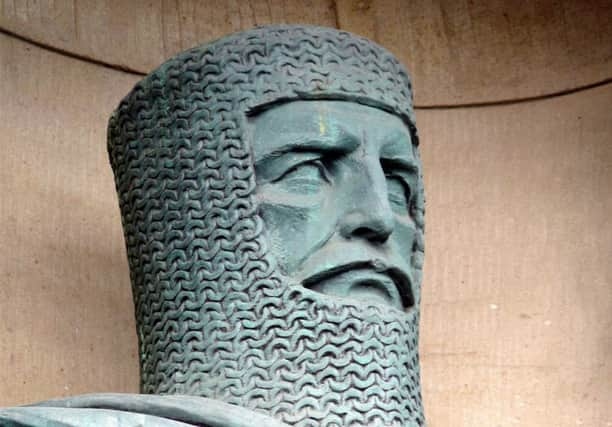A brief history of William Wallace


Despite his status as one of the most well-known figures in Scottish history, there are still elements of William Wallace's life that remain shrouded in mystery.
During the Wars of Scottish Independence, he was one of the men who led the charge against Edward I's English forces.
Advertisement
Hide AdAdvertisement
Hide AdHe was appointed as a Guardian of Scotland, and took it upon himself to protect his country from attack.
However, despite his important role in Scotland's story, historians know relatively little about his life.
Michael Brown, Professor of History at the University of St Andrews explains why this may be.
“William was from outside the circle of lords and barons who provided the leadership of the kingdom beneath the king,” he tells The Scotsman.
“He may have been from a knightly family - perhaps tenants of the Stewarts - or possibly from a non-noble class of free-holding peasants.”
Being of a lower social origin than the most powerful nobility, there are few reliable sources which give details about Wallace's life.
Wallace's motivation for rebelling against English forces are much more clear-cut.
Brown describes his rebellion as “a reaction to the conquest of Scotland by Edward I the previous year.
Advertisement
Hide AdAdvertisement
Hide Ad"Edward had humiliated the Scottish king and kingdom and imposed a government of English officials with orders to raise men and supplies for Edward’s planned campaign in France.”
However, there are also parts of Wallace's motivation for rebellion which may have been much more personal:
“Wallace’s personal role in this uprising appeared in chronicles from over a hundred years later which spoke of the killing of his wife by an English soldier,” says Brown.
“Earlier accounts have him slaying the English sheriff of Lanark. It is not unreasonable to think that Wallace provided leadership in a local uprising against hated foreign officials.”
Wallace is probably best known for his victory at Stirling Bridge. However, Brown reckons the famous victory was not entirely due to military skill.
“He got lucky!” Brown states.
“Along with the northern leader Andrew Murray, Wallace mustered their army across the River Forth from the English force which was encamped around the town and castle of Stirling.
"With incredible stupidity, the English commander ordered his men over the narrow bridge.
"As soon as enough of the enemy were across, Wallace and Murray attacked and destroyed the isolated English vanguard.”
Advertisement
Hide AdAdvertisement
Hide AdOn 11 September, 1297, Wallace and Moray were appointed as Guardians of Scotland.
“The guardians were replacements for an absent king,” Brown explains.
“They fulfilled the king’s prime roles as keepers of the peace, responsible for upholding justice and law, and defenders of the realm, leading personally in war.
Wallace, as leader of the army which had won at Stirling Bridge, was chosen as the man best able to protect Scotland from Edward’s inevitable counter attack.”
However, Wallace's success in the battlefield could not last forever. In July 1298, Wallace's forces suffered heavy losses at the Battle of Falkirk.
Brown argues that Wallace lost the battle because the English forces were better equipped than his own.
“Wallace chose to risk a battle in the open against an enemy force which had far more heavy cavalry and archers than his own army of lightly-armoured spearmen.
"His decision to fight on these terms has been criticised by historians but probably reflected that, as a man with limited noble support, he needed to show his ability to defend Scotland against Edward.”
Advertisement
Hide AdAdvertisement
Hide AdThe was also another reason why Wallace lost the Battle of Falkirk, as Brown describes: “Once battle was joined only a sudden loss of nerve by the English would have saved the Scots.
"Edward I was not a man to lose nerve. Although his army suffered considerable losses, they ground down the Scots with arrows and cavalry charges until they broke and fled.”
From this moment onward, Wallace's luck continued to fail him.
“Wallace returned to Scotland in 1303 but the following year, with the fall of Stirling Castle, active resistance to Edward I largely ceased,” Brown says.
“While most leading Scots were allowed to make peace with their new lord, Edward refused to allow Wallace to be given terms of submission.
"Instead, as a condition of their pardons, he made several Scots agree to capture William and hand him over.
"He was captured near Glasgow in 1305 by a Scottish noble, John Stewart of Menteith who handed him over to Edward’s officials.”
Later that year, William Wallace was tried, found to be a traitor, and executed at the Tower of London.
Advertisement
Hide AdAdvertisement
Hide Ad“The English king probably saw him as an example to Scots of the price of resistance,” says Brown.
“However, he had also created a powerful martyr for the cause of Scottish independence.”
Although Wallace was defeated, he was succeeded by Robert the Bruce as a Guardian of Scotland.
Bruce would become King of Scotland in 1320, realising his predecessor's dream of independence for Scotland.
Wallace's legacy is still very much present today – the Wallace Monument in Stirling is a fitting tribute to his achievements as a leader of the Scots.